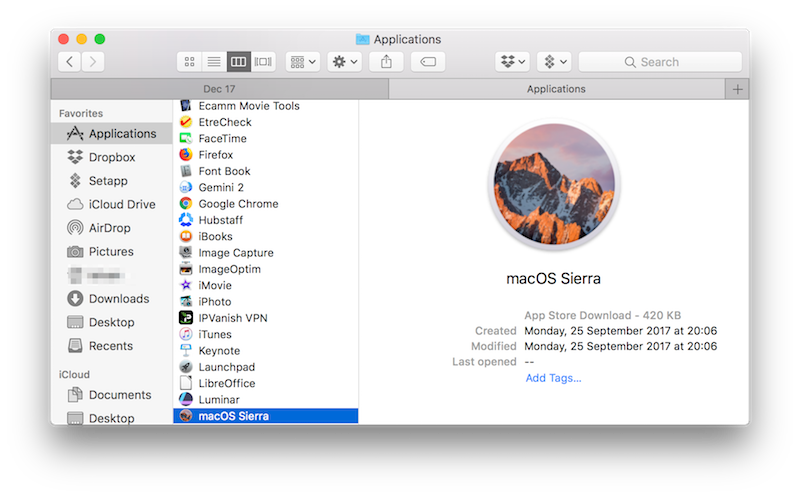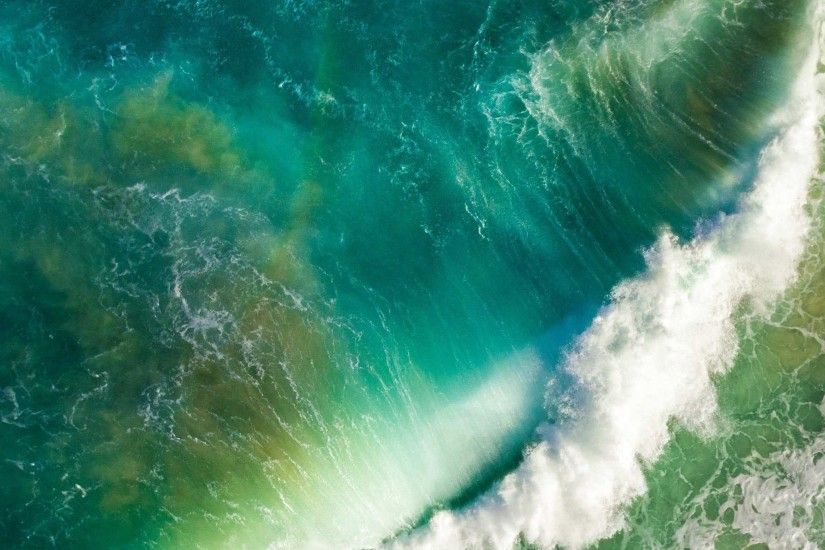While the yearly major macOS update system is free to install, it is still limited to Macs that Apple deems compatible, and every year a generation of Macs essentially becomes obsolete. This is despite the fact that Apple is eager to emphasize that macOS is a widely compatible operating system.
As it happens, there are still people with close to ten-year-old Apple desktop computers still in use on a daily basis, likely performing a range of lighter tasks.
Download CleanMyMac X from MacPaw’s website and clean up to 500MB of junk data from your computer while enjoying all the features of the software without major limitations.
Which Macs Don't Support High Sierra
STEP 2: Download macOS Monterey. The next step is to download macOS Monterey. Normally, you won't be able to get new updates as you're using unsupported Mac and Apple will block updates for new OS. However, there's another workaround available and you can download the copy of macOS Monterey very easily. Open the 'macOS Sierra Patcher' tool, and browse for your copy of the macOS Sierra Installer App.Ensure that the tool successfully verifies the app. Next, select your USB drive in the Target Volume list, and click 'Start Operation.' When the operation completes, boot your target unsupported Mac off the USB drive you just created. Insert your desired USB drive, open Disk Utility, and format it as OS X Extended (Journaled). Open the 'macOS High Sierra Patcher' tool, and browse for your copy of the macOS High Sierra Installer App.Ensure that the tool successfully verifies the app. Next, select your USB drive in the Target Volume list, and click 'Start Operation.'
For some reason Apple doesn't want to allow these Macs to run one of its latest operating systems, namely macOS 10.13 High Sierra. This leaves the following Macs on macOS 10.11 El Capitan:
- MacBook Pro – late-2009 or earlier models
- MacBook – late-2008 or earlier models
- MacBook Air – 2009 or earlier models
- iMac – late-2008 or earlier models
- Mac Mini – 2009 or earlier models
- Mac Pro – 2009 or earlier models.
These machines are considered obsolete and vintage by Apple. The company defines vintage products as those that have not been manufactured for more than five years but less than seven years ago. Obsolete products are those discontinued more than seven years ago.
How To Install macOS High Sierra on Unsupported Macs
Though Apple doesn't support the above hardware officially, someone has thought about sharing the love for these older machines. A developer known as DOSDude1 has written a patch that works on Macs with the Penryn architecture. Using this still imposes certain limitations, but at least makes it possible to install macOS High Sierra on the following Macs:
- Early-2008 or newer Mac Pro, iMac, or MacBook Pro (MacPro 3,1 and 4,1, iMac 8,1 and 9,1, MacBook Pro 4,1, 5,1, 5,2, 5,3, 5,4, and 5,5).
- Late-2008 or newer MacBook Air or Aluminum Unibody MacBook (MacBook Air 2,1, MacBook 5,1).
- Early-2009 or newer Mac Mini or white MacBook (Mac Mini 3,1, MacBook 5,2)
- Early-2008 or newer Xserve (Xserve 2,1, Xserve 3,1).

If you happen to own any of the Penryn Macs mentioned above, the macOS High Sierra Patch Tool written by DOSDude1 will make running the latest software possible. But remember, with High Sierra you will also migrate to the Apple File System, and it is highly recommended that you first disable SIP because it may prevent the patch from working at all.
Installing the operating system on any of these Macs will require some technical knowledge, so it is not recommended for novice users. Also, a backup of your data is always a good idea in case anything goes wrong.

While there is a full step-by-step tutorial and video tutorial available on DOSDude1's website, it’s good to get a summary of the basics, which start with downloading the macOS High Sierra Installer app from the Mac App Store:
- Format a USB drive as Mac OS Extended (Journaled) via Disk Utility.
- Open the macOS High Sierra Patcher tool, navigate to the High Sierra Installer App, then select your pen drive and click “Start Operation”.
- Boot from the USB drive by holding down the option key after reboot.
- Install macOS normally, reboot back on the installer drive, and then open the “macOS Post Install” application.
- From the options, select the Mac model you own. This step is important, because it contains the optimal patch for that specific model.
- Click the “Patch” button, and after the process has finished, click “Reboot”.
The Reason Not To Install macOS High Sierra on an Unsupported Mac
As you may have already experienced with other types of officially unsupported machines, the probability of having issues is much higher. The same applies in this case, too, since the macOS High Sierra Patcher will render your iMac 8.1 Broadcom Wi-Fi chip useless for certain models.
Macs that use the Broadcom BCM4321 Wi-Fi module will not have functional Wi-Fi when running High Sierra. Another issue that has been highlighted by the developer is that the trackpad in the MacBook 5,2 isn't fully supported in this version of OS.
These are just a few of the possible issues that could arise, and this is before even mentioning the various potential software errors that you can run into by using out-of-date hardware. Without getting the proper knowledge beforehand, you'll need to revert back to the previous state of the Mac, which won't be an easy process, especially not without a Time Machine backup.
Best Mac Optimization Software of 2021
| Rank | Company | Info | Visit |
| |||
| |||
|
Macos High Sierra Unsupported Mac
Get the Best Deals on Mac Optimization Software
Stay up to date on the latest tech news and discounts on Mac optimization software with our monthly newsletter.
For the first time since Apple released OS X 10.8 Mountain Lion in July 2012, Apple has dropped support for a number of older Macs that had supported OS X 10.8 through 10.11 El Capitan. No MacBook and iMac models prior to Late 2009 and no MacBook Air, MacBook Pro, Mac mini, and Mac Pro models prior. OS X El Capitan (10.11) on Unsupported Macs macOS Extractor and MacPostFactor are apps that guide you through patching and installing OS X El Capitan (10.11), Yosemite (10.10), Mavericks (10.9), or Mountain Lion (10.8) on your older Mac. Whilst it does lessen security somewhat, it is not the end of the world, and OS versions prior to El Capitan do not include it anyway. Related tutorial: How to disable System Integrity Protection 7) Once everything is ready, launch the macOS Sierra Patcher application. Question: I read somewhere that it is possible to install the latest version of OSX 10.10 Yosemite on my Mac, even though the official installer refuses to install. Can you give me any directions? Answer: Installing newer versions of OSX on slightly older Macs that do not meet the official system requirements. I am currently researching installing OS X 10.13 High Sierra on unsupported Macs. I did the Sierra upgrade on a couple of MacPros 4,1 and it has worked excellently, after I did a firmware update patch to get it to read as a MacPro 5,1, so I am very optimistic on doing it again.
For the first time since Apple released OS X 10.8 Mountain Lion in July 2012, Apple has dropped support for a number of older Macs that had supported OS X 10.8 through 10.11 El Capitan. No MacBook and iMac models prior to Late 2009 and no MacBook Air, MacBook Pro, Mac mini, and Mac Pro models prior to 2010 are officially supported by macOS Sierra, although workarounds have been developed for most unsupported 2008 and 2009 Macs.
Mac OS X is no longer being called OS X, and Apple is not promoting Sierra with a version number either (however, it is internally identified as OS X 10.12). Now it’s simply macOS Sierra – in keeping with iOS, tvOS, and watchOS.
macOS Sierra was released on Sept. 20, 2016 and officially requires a supported Mac with at least 2 GB of system memory and 8.8 GB of available storage space. (We recommend at least 4 GB of RAM.)
Officially Supported Macs
All Late 2009 and later MacBook and iMac models are supported in macOS Sierra, as are all 2010 and newer MacBook Air, MacBook Pro, Mac mini, and Mac Pro computers.
Hacking macOS Sierra for Unsupported Macs
Hardware requirements for macOS Sierre include a CPU with SSE4.1, so it cannot be run on any Mac with a CPU prior to the Penryn Core 2 Duo. In theory, it should be possible to get Sierra running on any Penryn or later Mac. It may be possible to swap out the Merom CPU in some Macs for a Penryn, which would then allow Sierra to run.
Sierra can run with 4 GB of system memory, but as with all recent versions of OS X, more memory will allow it to run even better.
Colin Mistr has published a macOS Sierra Patch Tool, which currently allows you to install and run macOS Sierra on the following officially unsupported hardware:
- Early 2008 iMac or later
- Mid 2009 MacBook (white) or later
- Late 2008 MacBook Air or later
- Early 2008 MacBook Pro or later
- Late 2009 Mac mini or later
- Early 2008 Mac Pro or later
Note: If you have the Early 2009 Mac Pro and have installed the firmware update patch so it identifies itself as MacPro5,1, you can run the standard installer. You do not need the patch tool.

You will need a USB drive 8 GB or larger and Mistr’s patch tool, which is linked on his page. WiFi does not function on these unsupported systems if they have the Broadcom BCM4321 WiFi module:
- Late 2008 and Mid 2009 MacBook Air
- Early 2008 and Mid 2008 MacBook Pro
New Features
Siri comes to the Mac with macOS Sierra.
macOS Sierra can automatically sync all files on your Desktop and in your Documents folder with other Macs running Sierra. You can also access these files in your iPhone or iPad using iCloud Drive.
The new Universal Clipboard lets you copy on one device and paste on another – whether it’s a Mac with Sierra or an iPhone or iPad with iOS 10.
Tabs are almost everywhere in Sierra, and they work much as they do in your browser. Third party apps will also be able to use tabs.
Apple Pay is now part of macOS, not just iOS.
If you have an Apple Watch, Auto Unlock will authenticate you and log you in automatically when you approach your Mac.
Mac Os El Capitan Patcher Tool For Unsupported Mac Store
Optimized Storage can store infrequently used files in iCloud while keeping them immediately available any time you are online.
Availability
Apple developers can download an early pre-release version of macOS Sierra today, and a beta version will be available to users in July. The full release is scheduled for Fall 2016.
Macos High Sierra 10.14
Keywords: #macossierra
Mac Os El Capitan Patcher
Short link: http://goo.gl/MkIekT
searchword: macossierra
Apple's OS X El Capitan in October got off to the fastest-ever one-month start for a Mac operating system.
El Capitan, also tagged by Apple as OS X 10.11, was released on the last day of September: 31 days later it had been installed on another 25% of all Macs, bumping its total to 27%, according to U.S. analytics firm Net Applications.

The October increase was the largest one-month user share gain by an edition of OS X in the six years that Computerworld has recorded Net Applications' data, beating Mavericks and Yosemite, the two previous upgrades Apple handed out free of charge.
Net Applications estimates operating system shares by tallying unique visitors to its clients' websites. In the absence of definitive data from Apple, user share is one of the few proxies for real-world OS X adoption.
When the release dates of each edition were taken into account, however, El Capitan's average daily adoption rate only edged Yosemite's and turned out to be lower than Mavericks'. Those forerunners launched in the second half of October in 2014 and 2013, respectively, and so spread their biggest gains over a longer stretch than El Capitan: 41 days for Mavericks and 47 days for Yosemite.
Not surprisingly, the majority of those who migrated to El Capitan came from its immediate predecessor, Yosemite. Last month, Yosemite shed more than a third of its user share as its users upgraded.
But other, even older versions of OS X also lost user share last month. Each of those tracked by Computerworld -- from 2007's Leopard on -- fell at rates larger than their average decline over the previous 12 months. Mavericks, for instance, fell to 14% of all editions of OS X, a two-point slide that was double its earlier average.
High Sierra Patcher
Mac Os El Capitan Patcher Tool For Unsupported Macs
Approximately 90% of all Macs were eligible to upgrade to El Capitan when the operating system launched on Sept. 30. El Capitan will run on the same Macs that have run Yosemite, Mavericks, 2012's Mountain Lion and 2011's Lion.
Macos Mojave
On the flip side, a sizable number of Macs continued to run outdated editions of OS X last month. By Net Applications' data, about 16%, representing one in six Macs, was powered by a version that Apple no longer supports with security updates. Apple distributed the final security update for the three-year-old Mountain Lion in August. It continues to patch Mavericks and Yosemite, however.
Dosdude Sierra
The one-in-six who run unsupported operating systems seems to be the natural order. Not only has that same percentage of OS X users been on the retired list in earlier years -- even as new editions rolled out annually -- but in the Windows world, a double-digit fraction still run Windows XP, which left support more than a year and a half ago.
The free El Capitan upgrade can be obtained from Apple's Mac App Store, and supports iMacs as old as mid-2007, MacBook Pro notebooks from late 2007 on, and MacBook Air laptops from late 2008 going forward.